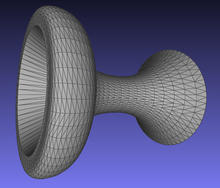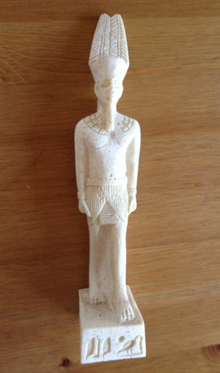User:MrGentleFish/sandbox/3d Printing

3D printing is a way of creating three dimensional (3D) solid objects.[1] 3D printing is done by building up the object layer by layer.[2] Usually, 3D printers use plastic, because it is easier to use and cheaper. Some 3D printers can 3D print with other materials, like metals and ceramics, but they cost too much money for most people.[3]
3D printers are useful because they can make new objects very fast, and are good at making them very detailed. This means an engineer can test a lot of new designs and not have to wait for someone else to make them. They are also useful for fixing parts made of plastic, and for making toys, figures, and models. There are a lot of people who print 3D objects at home.
Since 2003, many more materials printers have been sold than before. Also, the cost of 3D printers has gone down.[4]
History[edit]
1974 David E. H. Jones first wrote about the idea of 3D printing in the journal New Scientist[5]
1984 Alain Le Méhauté and others filed a patent for stereolithography (a laser-based 3D printer). [6]
1989: S. Scott Crump developed FDM. It is the technology used by most 3D printers today. [7]
1992 The first FDM machine was sold in 1992 by S. Scott Crump's company, Stratasys.[8]
2005 RepRap became the first open source printer project [9]
2008 Shapeways became the first service that would 3D print an object and send it to customers [10]
2017 The first 3D printed house that humans could live in was built in Russia [11]
How They Work[edit]

Modelling[edit]
The first step in 3D printing something is to make it on a computer. People do this with CAD (Computer Aided Design) software or a 3D scanner. To design models in CAD, people start with basic shapes, and build from that point. 3D scanners are machines that take lots of measurements of the object and automatically make a model on the computer. They can be very fast, but are also more expensive. [12]
CAD models are usually saved on computers as STL files. They are saved as lots of triangles, which saves space on the computer.[13]
Printing[edit]
There are a lot of different ways that 3D printers work. There are also many different materials that can be used. Every method and material has its advantages and disadvantages. [14]
The main things to think about when choosing a machine are usually speed, costs, and color. Printers that work directly with metals are generally expensive. However less expensive printers can be used to make a mold, which is then used to make metal parts.

Typical layers are around 100 μm thick, or about one tenth the thickness of a human hair.[15] Prints can take anywhere from less than an hour to many days, depending on how complicated and big it is. [16]
Finishing[edit]
After the machine has finished printing, sometimes people finish the model. This means making small fixes to make it look better. Finishing includes taking off material that the printer placed to support the model. This sometimes can take a lot of time. There are ways to make it quicker, but it is often easiest to remove plastic by hand. [17]
Uses[edit]
DIY[edit]
Lots of people are trying to develop cheap 3D printers for people to use at home.[18] Libraries have also started to buy smaller 3D printers so that people can learn about them without having to buy one. Lots of work has been done by DIY communities, as well as schools and hacker communities. By 2017, more people were starting to use 3D printing in their own home for small items such as gears and small decorations.[19][20]

Medical[edit]
3D printing is used to make medical supplies cheaply. People think that the two biggest uses will be making hearing aids and false teeth [21]
In March 2014, surgeons in Swansea used 3D printed parts to rebuild the face of a motorcyclist who had been badly injured in a road accident.[citation needed]

Manufacturing[edit]
In 2014, a supercar was made by a Swedish comapany that utilizes many 3D printed components. Urbee was the first car in the world to have its bodywork and windows 3D printed. [22][23]
In 2015, a Royal Air Force Eurofighter Typhoon fighter jet flew with 3D printed parts. The United States Air Force has begun to work with 3D printers, and the Israeli Air Force has also purchased a 3D printer to print spare parts.[24]

Food[edit]
Food can be 3D printed. Lots of different foods can be printed, like chocolate and candy, and also flat foods such as crackers, pasta, and pizza. [25]NASA is printing food to create less waste and to make food that has all the right nutrients for astronauts.[26] In 2018, Giuseppe Scionti printed a food that was similar to meat.[27]

Guns[edit]
In 2012, Defense Distributed uploaded files to the internet for a 3D printed gun "that could be downloaded and reproduced by anybody with a 3D printer". After Defense Distributed released their plans, people were worried that they may cause problems with gun control[citation needed] A year later, in May 2013, the US State Department asked Defense Distributed to take down the plans, which they did. [28]
Historical[edit]
In the last several years 3D printing has been used to make sure that important things from history are safe.[29] Many museums have bought 3D printers and are making pieces to fix their relics.[30] The Metropolitan Museum of Art and the British Museum have started using their 3D printers to make replicas to sell in the gift shop.[31] The National Museum of Military History and Varna Historical Museum sell digital versions of their items online, which everyone can 3D print at home.[32]
References[edit]
- ^ The engineer: The rise of additive manufacturing
- ^ "3D Printer Technology - Animation of layering". Create It Real. Retrieved 2012-01-31.
- ^ "How Much Does a Metal 3D Printer Cost in 2019?". All3DP. 2019-07-02. Retrieved 2019-11-14.
- ^ Sherman, Lilli Manolis. "3D Printers Lead Growth of Rapid Prototyping (Plastics Technology, August 2004)". Retrieved 2012-01-31.
- ^ "You Read It Here First". Science. 291 (5501): 39b–39. 2001-01-05. doi:10.1126/science.291.5501.39b. ISSN 0036-8075.
- ^ "Notice". bases-brevets.inpi.fr. Retrieved 2019-11-13.
- ^ [1], "Apparatus and method for creating three-dimensional objects", issued 1989-10-30
- ^ "History of Stratasys, Inc. – FundingUniverse". www.fundinguniverse.com. Retrieved 2019-11-17.
- ^ Jones, Rhys; Haufe, Patrick; Sells, Edward; Iravani, Pejman; Olliver, Vik; Palmer, Chris; Bowyer, Adrian (2011/01). "RepRap – the replicating rapid prototyper". Robotica. 29 (1): 177–191. doi:10.1017/S026357471000069X. ISSN 1469-8668.
{{cite journal}}: Check date values in:|date=(help) - ^ www.digitaltrends.com https://www.digitaltrends.com/cool-tech/history-of-3d-printing-milestones/. Retrieved 2019-11-20.
{{cite web}}: Missing or empty|title=(help) - ^ "AMT-SPECAVIA builds Europe's first habitable 3D printed building". 3ders.org. Retrieved 2019-11-20.
- ^ Vermeulen, M. M. P. A.; Rosielle, P. C. J. N.; Schellekens, P. H. J. (1998-01-01). "Design of a High-Precision 3D-Coordinate Measuring Machine". CIRP Annals. 47 (1): 447–450. doi:10.1016/S0007-8506(07)62871-6. ISSN 0007-8506.
- ^ Jurnal Teknologi. Johor Bahru: Penerbit UTM Press. 1977. OCLC 889967279.
- ^ "A whole new dimension". The Economist. 2007-11-15. ISSN 0013-0613. Retrieved 2019-11-13.
- ^ "Here's What Experts Say About The Thickness Of Human Hair". TOP Cambodian Hair and Vietnam Human Virgin Hair Extensions. 2018-08-05. Retrieved 2019-11-20.
- ^ Andy (2013-07-10). "Advantages of 3D printing over traditional manufacturing". 3DPrinterPrices.net. Retrieved 2019-11-13.
- ^ "Best way to remove rafts, supports and other extraneous filament?". Talk Manufacturing | 3D Hubs. 2015-01-30. Retrieved 2019-11-20.
- ^ Printers, Matt Hanson 2019-11-19T19:43:25Z; scanners. "Best 3D printers of 2019". TechRadar. Retrieved 2019-11-20.
{{cite web}}: CS1 maint: numeric names: authors list (link) - ^ "UMass Amherst Library Opens 3-D Printing Innovation Center". web.archive.org. 2015-04-02. Retrieved 2019-11-13.
- ^ Sauers, Michael (2015-01-12). "A Map of 3D Printers in Libraries". The Travelin' Librarian. Retrieved 2019-11-17.
- ^ Corsini, Lucia; Aranda-Jan, C. B.; Moultrie, James (2019-08-01). "Using digital fabrication tools to provide humanitarian and development aid in low-resource settings". doi:10.17863/CAM.37408. ISSN 0160-791X.
{{cite journal}}: Cite journal requires|journal=(help) - ^ Eternity, Max. "The "Urbee" 3D-Printed Car: Coast to Coast on 10 Gallons?". Truthout. Retrieved 2019-11-22.
- ^ 3D Printed Car Creator Discusses Future of the Urbee, retrieved 2019-11-22
- ^ "The 3D printer revolution comes to the IAF". Ynetnews. 2015-07-27. Retrieved 2019-11-22.
- ^ "NASA Astronauts Can Now 3D-Print Pizzas in Space". Futurism. Retrieved 2019-12-03.
- ^ Hall, Loura (2013-06-07). "3D Printing: Food in Space". NASA. Retrieved 2019-12-03.
- ^ "Researchers Develop Plant Based Steak Printing Method". 3D Printing. 2018-09-28. Retrieved 2019-12-03.
- ^ Bump, Philip (2013-05-09). "State Department Asks Defense Distributed to Take Down Its 3D-Printed Gun Plans". The Atlantic. Retrieved 2019-11-22.
- ^ Scopigno, R.; Cignoni, P.; Pietroni, N.; Callieri, M.; Dellepiane, M. (2017-01). "Digital Fabrication Techniques for Cultural Heritage: A Survey: Fabrication Techniques for Cultural Heritage". Computer Graphics Forum. 36 (1): 6–21. doi:10.1111/cgf.12781.
{{cite journal}}: Check date values in:|date=(help) - ^ "3ders.org - Museum uses 3D printing to take fragile maquette by Thomas Hart Benton on tour through the States | 3D Printer News & 3D Printing News". web.archive.org. 2015-11-17. Retrieved 2019-11-22.
- ^ "British Museum releases 3D printer scans of artefacts". The Independent. 2014-11-04. Retrieved 2019-11-22.
- ^ O'Neal, Bridget (02/20/15). "Threeding Uses Artec 3D Scanning Technology to Catalog 3D Models for Bulgaria's National Museum of Military History". 3DPrint.com.
{{cite web}}: Check date values in:|date=(help)CS1 maint: url-status (link)
